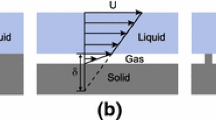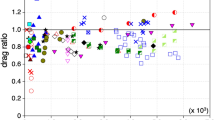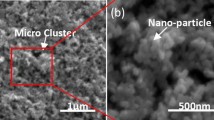Abstract
Shear-driven flows over superhydrophobic surfaces formed of closely spaced circular bubbles are characterized by giant longitudinal slip lengths, viz., large compared with the periodicity (Schnitzer, Phys Rev Fluids 1(5):052101, 2016). This hints towards a strong superhydrophobic effect in the concomitant scenario of pressure-driven flow between two such surfaces, particularly for non-wide channels where bubble-to-bubble pitch and bubble radius are commensurate with channel width. We show here that such pressure-driven flows can be analyzed asymptotically and in closed form based on the smallness of the gaps separating the bubbles relative to the channel width (and bubble radius). We find that the flow adopts an unconventional plug profile away from the inter-bubble gaps, with the uniform velocity being asymptotically larger than the corresponding Poiseuille scale. For a given solid fraction and channel width, the net volumetric flux is maximized when the length of each semi-circular bubble-liquid interface is equal to the channel width. The plug flow identified herein cannot be obtained via a naive implementation of a Navier condition, which is indeed inapplicable for non-wide channels.


Similar content being viewed by others
References
Ou J, Perot B, Rothstein JP (2004) Laminar drag reduction in microchannels using ultrahydrophobic surfaces. Phys Fluids 16:4635–4643
Ou J, Rothstein JP (2005) Direct velocity measurements of the flow past drag-reducing ultrahydrophobic surfaces. Phys Fluids 17:103606–11
Cottin-Bizonne C, Barentin C, Charlaix É, Bocquet L, Barrat J-L (2004) Dynamics of simple liquids at heterogeneous surfaces: molecular-dynamics simulations and hydrodynamic description. Eur Phys J E Soft Matter 15:427–438
Ybert C, Barentin C, Cottin-Bizonne C, Joseph P, Bocquet L (2007) Achieving large slip with superhydrophobic surfaces: scaling laws for generic geometries. Phys Fluids 19:123601
Davis AMJ, Lauga E (2010) Hydrodynamic friction of fakir-like superhydrophobic surfaces. J Fluid Mech 661:402–411
Lauga E, Stone HA (2003) Effective slip in pressure-driven stokes flow. J Fluid Mech 489:55–77
Philip JR (1972) Flows satisfying mixed no-slip and no-shear conditions. Z Angew Math Phys 23:353–372
Schnitzer O (2016) Singular effective slip length for longitudinal flow over a dense bubble mattress. Phys Rev Fluids 1(5):052101
Karatay E, Haase AS, Visser CW, Sun C, Lohse D, Tsai PA, Lammertink RGH (2013) Control of slippage with tunable bubble mattresses. Proc Natl Acad Sci USA 110:8422–8426
Schnitzer O (2017) Slip length for longitudinal shear flow over an arbitrary-protrusion-angle bubble mattress: the small-solid-fraction singularity. J Fluid Mech 820:580–603
Choi C-H, Kim C-J (2006) Large slip of aqueous liquid flow over a nanoengineered superhydrophobic surface. Phys Rev Lett 96:066001
Lee C, Choi C-H, Kim C-J (2008) Structured surfaces for a giant liquid slip. Phys Rev Lett 101:064501
Marshall JS (2017) Exact formulae for the effective slip length of a symmetric superhydrophobic channel with flat or weakly curved menisci. SIAM J Appl Math 77:1606–1630
Feuillebois F, Bazant MZ, Vinogradova OI (2009) Effective slip over superhydrophobic surfaces in thin channels. Phys Rev Lett 102:026001
Schnitzer O, Yariv E (2017) Longitudinal pressure-driven flows between superhydrophobic grooved surfaces: large effective slip in the narrow-channel limit. Phys Rev Fluids 2:072101
Yariv E (2017) Velocity amplification in pressure-driven flows between superhydrophobic gratings of small solid fraction. Soft Matter 13:6287–6292
Sbragaglia M, Prosperetti A (2007) A note on the effective slip properties for microchannel flows with ultrahydrophobic surfaces. Phys Fluids 19:043603
Teo CJ, Khoo BC (2009) Analysis of stokes flow in microchannels with superhydrophobic surfaces containing a periodic array of micro-grooves. Microfluid Nanofluid 7:353–382
Belyaev AV, Vinogradova OI (2010) Hydrodynamic interaction with super-hydrophobic surfaces. Soft Matter 6:4563–4570
Teo CJ, Khoo BC (2010) Flow past superhydrophobic surfaces containing longitudinal grooves: effects of interface curvature. Microfluid Nanofluid 9:499–511
Teo CJ, Khoo BC (2014) Effects of interface curvature on poiseuille flow through microchannels and microtubes containing superhydrophobic surfaces with transverse grooves and ribs. Microfluid Nanofluid 17:891–905
Hinch EJ (1991) Perturbation methods. Cambridge University Press, Cambridge
Pozrikidis C (1992) Boundary integral and singularity methods for linearized viscous flow. Cambridge University Press, Cambridge
Acknowledgements
Ehud Yariv was supported by the Israel Science Foundation (Grant No. 1081/16).
Author information
Authors and Affiliations
Corresponding author
Appendix: Boundary-integral computation
Appendix: Boundary-integral computation
With w satisfying Poisson’s equation, it is straightforward to solve the preceding problem using a boundary-integral formulation [23]. We define the harmonic function \(\varphi = w + x^2/2\) and employ Green’s third identity,
wherein \(\mathbf {x}_0\) is a point on the boundary \(\partial \mathcal {D}\) and the Green function \(g(\mathbf {x},\mathbf {x}_0)\) satisfies \(\nabla ^2 g = \delta (\mathbf {x}-\mathbf {x}_0)\). For convenience, we employ here the free-space Green function, \(g = (2\pi )^{-1} \ln |\mathbf {x}-\mathbf {x}_0|\). Discretization of (A.1) in conjunction with the boundary conditions governing \(\varphi \) (which readily follow from those governing w) yields 2N equations governing the values of \(\varphi \) and \(\partial \varphi /\partial n\) at N collocation points on \(\partial \mathcal {D}\). Once \(\varphi \) (and whence w) is determined on the boundary, \(\bar{w}\) is readily evaluated upon making use of Green’s second identity.
Rights and permissions
About this article
Cite this article
Yariv, E., Schnitzer, O. Pressure-driven plug flows between superhydrophobic surfaces of closely spaced circular bubbles. J Eng Math 111, 15–22 (2018). https://doi.org/10.1007/s10665-018-9952-z
Received:
Accepted:
Published:
Issue Date:
DOI: https://doi.org/10.1007/s10665-018-9952-z




